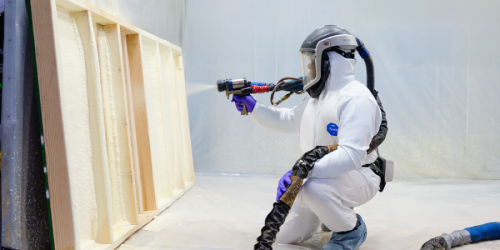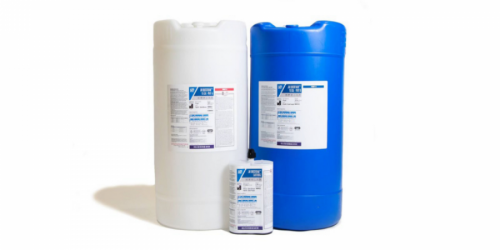Q&A Forums
Icynene problems Post New Topic | Post Reply
| Author | Comments |
|---|---|
|
Posted: Feb 25, 2010 07:30 AM
|
Icynene problems
HI-- I insulated my house (rebuilt after a housefire) with Icynene-- i told the installation folks that where I lived (1600ft) was colder than where they were, and they had better get up there before November if they wanted to do a good job-- they said no problem. The installers came wearing shorts and couldn't believe the temp inside the structure, even with 4 salamanders running. They sprayed anyway, and the Icynene pulled back from the walls leaving voids. They said they'd take care of it, and tried to backfill later but there were still voids behind where they had sprayed. The walls were cold to the touch, and you could literally feel air movement with your hand against the sheetrock when the walls were finished and the wind was blowing. Now the mice are having a field-day as they love to chew Icynene and make tunnels through it. I can hear them chomping away but can't get to them. All around the basement floor, there are piles of chewed Icynene, and there are even a couple places where they've burrowed/chewed right through to the plywood on the outside. I've had an exterminator in, set poison, traps, etc. but they keep on chewing. Now I wish I'd gone the toxic foam route, or cellulose as i think both of those inhibit varmint and insect chewing-- I wish I'd known this before I insulated and keep googling for solutions-- anyone have any ideas?
|
|
jimcoler
I have over 10 years of experience specifying and installing open and closed cell spray foam. I've sold my business but I'm still selling for the new owners and consulting on large and custom specific jobs. I've expanded my knowledge into t Posted: Feb 25, 2010 08:45 AM
|
The first problem that I can tell from your post is that you were using 4 salamander heaters prior to installing the Icynene. This provides way too much moisture into the air and contributes to the pull back. They should have not used the salamander heaters before spraying. This being said, the soultion is not one you want to hear... Tear out the drywall and insulation that's necessary to gain access to these areas. Now, the rodents on the other hand are a different animal (no pun intended). I would use poison bait to kill them off as best as you can and seal up the holes from the outside! |
|
mason
Posted: Feb 25, 2010 09:02 AM
|
I agree with Jim, at this stage of the game you have to indentify the voids and gaps, remove and replace the foam. Be sure to contact Icynene with your situation and see what they can do to help. |
|
Edward Brassington
Posted: Feb 25, 2010 08:03 PM
|
Good luck with getting this manufacturer to help you out. They always blame it on installer error and assume no responsibility for the failure of the product. That is the reason we no longer install this product. You might try finding someone with a thermal infra red camera to do a scan of the house and see where the problems are. |
|
JohnPeters
Posted: Mar 24, 2010 09:32 PM
|
A propane burning heater will introduce countless gallons of water into the air in a given work day. I cannot imagine what 4 of them would do. SPF 101 - no propane heaters. jp |
|
steven argus
Posted: Mar 24, 2010 11:00 PM
|
"toxic foam" havn't heard that one yet. I'f those mice are chewin through the plywood, they're gonna get through 1/2# foam. Were the heaters propane fired or kerosene fired? Kerosene will not be a problem, but 4 propane heaters are. Too much moisture is bad for foam. |
|
steven argus
Posted: Mar 24, 2010 11:08 PM
|
What about the fact that the house had a fire? What condition was the substrate in? We spray in the Northeast all winter long, kerosene heaters and 35 degree substrate. We loose yeild, but the foam sticks. Find the voids with an infared gun. Drill holes in drywall or sheathing, which ever is easier, and inject the foam. It's tricky to do, but can be done. Rather than pull out the drywall and start over. Worst case, you blow out some drywall and would have to fix it anyway. |
|
Posted: Mar 25, 2010 07:42 AM
|
Hi, again-- substrate was fine (complete rebuild), and there were no salamanders running when they started the job (they thought it would be warm enough but once they started spraying they said they'd have to come back the next day and I should pick up some salamanders and they would bring theirs). The mice appear to be on the inside, no holes to the outside, and I've been laying down poison for about a year. It helped drop the population but now the ones that are left must be avoiding it. Do you think the installer has any obligation to make it right or is it the company's obligation? I called the installer and their recommendation was to get an infrared camera so I actually bought one on eBay and have started learning how to use it (no one had one around here except the fire dept and they weren't too interested in loaning it out). Anyway, how hard is it to inject insulation into the voids from the inside? Is it something most foam installers can do (I can see the voids all along the joint of the interior walls and the ceilings, worse in some rooms, and some areas in the middle of the walls)? Thanks |
|
mason
Posted: Mar 25, 2010 08:18 AM
|
It would be difficult to find and fill the voids. If you have specific areas that the infra red scan showed voids and gaps, remove the foam in those areas and respray. If they are scattered throughout the house, remove all the foam and respray. As for the mice, after the foam is removed, call an exterminator before respraying. |
|
Posted: Mar 25, 2010 08:25 AM
|
Hi-- you're the only one that said the walls could be drilled from the inside or outside and voids filled with a gun-- everyone else is saying remove the foam and start again (something I HATE doing now that I'm back in my house after almost 5 years). Are you in the New England area and is this something you would consider doing? Thanks |
|
steven argus
Posted: Mar 25, 2010 01:56 PM
|
I'm sorry, but I would not travel that far. Also, I would be very hesitant about fixing another contractors mistake. I don't beleive the foam needs to be removed, unless the foam was sprayed off ratio. If it was sprayed of ratio, yes, pull it all out. But if the foam was good, patch it. Any experienced contractor can tell what good foam looks like. If the voids were caused my moisture or contractor error, patch it. If you can see the voids with the infared, drill a 1/2" hole where the void is. Your wall will end up looking like swiss cheese, but the holes are easy to patch. The whole inside of your house needs to be covered with plastic and I would reccomend adding more drywall screws to each stud to help hold the drywall in place. We somtimes use a jetstream adapter for our gun, not a pour adapter, the jet stream is less messy. Drill the hole, insert gun, say a prayer and pull the trigger- start off with a 3-4 second count and stand back, but put your hand over the hole, the foam can come right back at you or all the way accross the room. That's why you need to cover everything. We inject 1/2# foam strictly by time and material, no way to estimate and no guarantees. Try asking George Spanos to help you find a contractor. He runs Spray Foam Distributors of New England. He should be able to help. |
|
quentin
Posted: Mar 26, 2010 11:13 AM
|
guiness beat me to it. Contact George. He is one heck of a guy, knows his business and I would trust him without reserves in my home. If it is mostly voids along the studs like it sounds, then it is likely off ration and shrank. Bad news then is pull it and redo it. Also tell the Icyliars to cover the FULL costs. The company is getting a bad name with good reason due to too many of their contractors being bad, their training having some serious issues and their claims being overstated. Bad part is they hurt their own good contractors and the rest of us. Just a hint, any major manufacture of foam will be good and there is only so many ways you can mix the same basic materials to go through the same exact machines and get the results so don't sweat the brand of foam. Here if the info for George. George Spanos President Spray Foam Distributors of NE Inc 603.348.8880 |
|
Posted: Mar 26, 2010 02:52 PM
|
Thanks for the suggestions-- was the plastic to protect the stuff in the house? I'll try contacting George-- sounds like I need to get a foam contractor in to do it right |
|
Posted: Mar 26, 2010 02:53 PM
|
Seems to be particularly where the walls meet the ceilings, and also at the vertical corners, and then some random voids. I'm still learning how to use the infrared camera-- pretty cool tool. Thanks for the suggestions. |





























